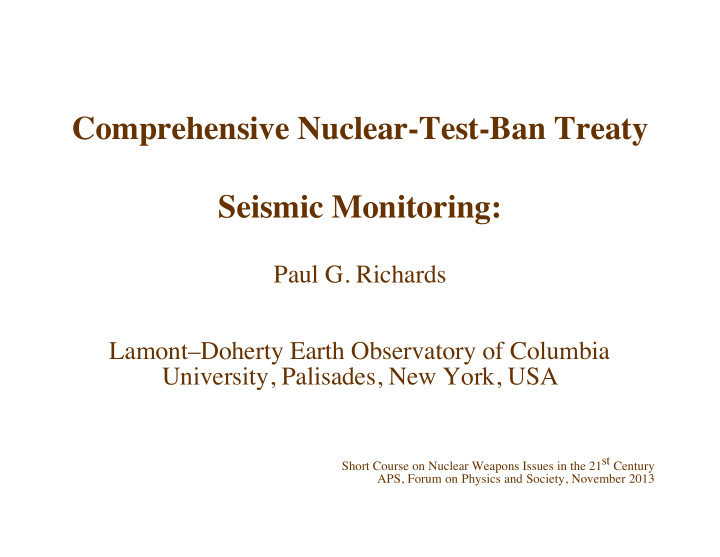



Comprehensive Nuclear-Test-Ban Treaty Seismic Monitoring: Paul G. Richards Lamont–Doherty Earth Observatory of Columbia University, Palisades, New York, USA Short Course on Nuclear Weapons Issues in the 21st Century APS, Forum on Physics and Society, November 2013
subtitle: 2012 NAS Report and Recent Explosions, Earthquakes, Meteorites
Comprehensive Test Ban Treaty (CTBT)
Comprehensive Test Ban Treaty (CTBT) negotiations started in 1958 Eisenhower
Comprehensive Test Ban Treaty (CTBT) negotiations started in 1958 Eisenhower .... Kennedy
Comprehensive Test Ban Treaty (CTBT) negotiations started in 1958 Eisenhower .... Kennedy Johnson
Comprehensive Test Ban Treaty (CTBT) negotiations started in 1958 Eisenhower .... Kennedy Johnson Nixon
Comprehensive Test Ban Treaty (CTBT) negotiations started in 1958 Eisenhower .... Kennedy Johnson Nixon Ford
Comprehensive Test Ban Treaty (CTBT) negotiations started in 1958 Eisenhower .... Kennedy Johnson Nixon Ford .... Carter
Comprehensive Test Ban Treaty (CTBT) negotiations started in 1958 Eisenhower .... Kennedy Johnson Nixon Ford .... Carter Reagan
Comprehensive Test Ban Treaty (CTBT) negotiations started in 1958 Eisenhower .... Kennedy Johnson Nixon Ford .... Carter Reagan (testing moratorium) Bush, G.H.W.
Comprehensive Test Ban Treaty (CTBT) negotiations started in 1958 Eisenhower .... Kennedy Johnson Nixon Ford .... Carter Reagan (testing moratorium) Bush, G.H.W. negotiations ended in 1996 Clinton
Comprehensive Test Ban Treaty (CTBT) negotiations started in 1958 Eisenhower .... Kennedy Johnson Nixon Ford .... Carter Reagan (testing moratorium) Bush, G.H.W. negotiations ended in 1996 Clinton (moratorium continued; UN votes) Bush, G.W.
Comprehensive Test Ban Treaty (CTBT) negotiations started in 1958 Eisenhower .... Kennedy Johnson Nixon Ford .... Carter Reagan (testing moratorium) Bush, G.H.W. negotiations ended in 1996 Clinton (moratorium continued; UN votes) Bush, G.W. (moratorium continued; UN votes) Obama
����������������������������������������������������������� ARTICLE I BASIC OBLIGATIONS 1. Each State Party undertakes not to carry out any nuclear weapon test explosion or any other nuclear explosion, and to prohibit and prevent any such nuclear explosion at any place under its jurisdiction or control. 2. Each State Party undertakes, furthermore, to refrain from causing, encouraging, or in any way participating in the carrying out of any nuclear weapon test explosion or any other nuclear explosion.
Total States (out of 193) as of ����������������� : 1 � � signed 1 �� ratified ����������������� ( 3 � of Annex 2, ratified � �������������� ������������������� ������������� ��������������� Total of the Required States having some nuclear capability (out of 44)
THE EFFECTS OF HIGH ALTITUDE EXPLOSIONS* by Wilmot N. Hess Goddard Space Flight Center Seven artificial radiation belts have been made by the explosion of high altitude nuclear bombs since 1958. These artificial belts result from the release of energetic charged particles, mostly electrons, from the nuclear explosions. These seven explosions are:t 1 Explosion Locale Yield Altitude Time __ Argus I South Atlantic 300 miles 1958 l k t Argus 1 1 South Atlantic 1958 l k t 300 miles Argus I D South Atlantic 1958 l k t 300 miles I 400 I Starfish Johnson Island, July 9, 1962 1.4 Mt Pacific Ocean USSRS Siberia Oct. 22, 1962 Several hundred kt ? USSR Siberia Oct. 28, 1962 ? ? Siberia USSR Nov. 1, 1962 ? ? ~ .- ~ The Argus explosions of 1958 were carried out to study the trapping of energetic particles by the earth's magnetic field. Nicholas Christofolis, a physicist at the Lawrence Radiation Laboratory, had for some time before Argus worked on Project Sherwood-the attempt to make controlled thermonuclear reactions in laboratory containers. To contain the intensely hot material used in the Sherwood experiments, no walls can be used; they would melt. Magnetic fields, shaped into "magnetic bottles" to contain the particles, are used. Such a bottle as that used in Figure 1 has been used successfully to contain hot electrons and protons for short times. The particles eventu- ally leak out of the magnetic bottle, mostly through the ends, but they are contained for a time. *To be published a s a chapter in"Space Physics,"edited by Donald P. LeGalley and Alan Rosen (publisher, John Wiley & Sons, Inc.). tThe U. S. explosions Teak and Orange in the Pacific (below 8 km) in 1758 may have injected some particles, but the effects here were small and short-lived. Another reported USSR high altitude explosion of 1961 may have produced some effects, but this is uncertain. $Atomic Energy Commission press releases of Oct. 22 and Nov. 1, 1962.
Contributions of key technologies to CTBT monitoring of different test environments Environment Key Underground Underwater Atmosphere Near Space of test Technologies Seismic * major major secondary none Radionuclide * major major major none Hydroacoustic * secondary major secondary none Infrasound * secondary secondary major none Electromagnetic secondary secondary major major Satellite Imagery major major secondary secondary * technologies used by the International Monitoring System (Vienna)
���������������������������������������������������� ����������� �������������������������������������������������� ��������������� ������������������������������������������������������������������ �������������� ������������������� ��������������������� �������������������������������������������������������������������� ��������������������� ����������������������������������������������������������������� ���������������������������� �����������������������������
������������������������������������������������������������������������������� POLICY � AND � GLOBAL � AFFAIRS The � National � Academies � Press Washington, � DC www.nap.edu March � 29, � 2012 3/29/2012 1 � � � � � � � � � � � � � � � � � � � � � � � � � � � � � � � � � � � � � � � � � � � � � � � � � � � � � � � � � � � � � � � � � � � � � � � � � � � � � � � � � � � �����������������������������������
http://www.ctbto.org and in particular http://www.ctbto.org/verification-regime/
90% con fi dence level ���� ����� ����� ���� ���� ���� �� ���� ���� ���� ����� ����� ���� ���� ���� ���� ���� ���� ���� 3.2 3.4 ���� ���� 3.4 ���� ���� 3.4 ���� ���� 3.4 �� �� 3.6 ���� ���� 3.6 ���� ���� 3.6 ���� ���� 3.6 3.6 3.6 ���� ���� 3.6 ���� ���� 3.6 ���� ���� ���� ����� ����� ���� ���� ���� �� ���� ���� ���� ����� ����� ���� Magnitude 3.0 3.2 3.4 3.6 3.8 4.0
Recommend
More recommend